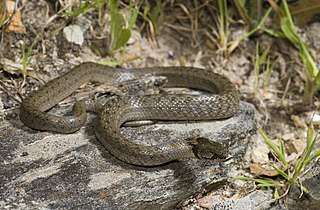
Garter snake is a common name for generally harmless, small to medium-sized snakes belonging to the genus Thamnophis in the family Colubridae. Native to North and Central America, species in the genus Thamnophis can be found from the subarctic plains of Canada to Costa Rica.

Marie Firmin Bocourt was a French zoologist and artist.

Acanthophis is a genus of elapid snakes. Commonly called death adders, they are native to Australia, New Guinea and nearby islands, and are among the most venomous snakes in the world. Despite their common name, they are not adders at all and belong to the Elapidae family. The name of the genus derives from the Ancient Greek akanthos/ἄκανθος ('spine') and ophis/ὄφις ('snake'), referring to the spine on the death adder's tail.

George Albert Boulenger was a Belgian-British zoologist who described and gave scientific names to over 2,000 new animal species, chiefly fish, reptiles, and amphibians. Boulenger was also an active botanist during the last 30 years of his life, especially in the study of roses.

Oligodon is genus of colubrid snakes that was first described by the Austrian zoologist Fitzinger in 1826. This genus is widespread throughout central and tropical Asia.

Cerberus rynchops, also known as the New Guinea bockadam, South Asian bockadam, bockadam snake, or dog-faced water snake, is a mildly venomous species of a snake in the family Homalopsidae. It is native to coastal waters of South and Southeast Asia. The species was re-delimited in 2012, allocating populations east and south of the west coast of Thailand to other species.

Dieurostus is a genus of snake in the family Homalopsidae. The genus Dieurostus is monotypic, containing only the species Dieurostus dussumieri, commonly known as Dussumier's water snake. The species, which is mildly venomous and rear-fanged, is endemic to Kerala, in southwestern India. It was formerly thought to be found in Bangladesh, although its distribution there is now disputed.

Tropidoclonion is a genus of snake in the subfamily Natricinae of the family Colubridae. The genus is monotypic, containing the sole species Tropidoclonion lineatum, commonly known as the lined snake. The species is endemic to North America.
Uropeltis is a genus of nonvenomous shield tail snakes endemic to peninsular India. As of 2020, 25 species are recognized as being valid.

The long-nosed snake is a species of nonvenomous snake in the family Colubridae. The species is endemic to North America. It has two recognized subspecies. The other species in the genus were previously considered subspecies.

Vipera is a genus of venomous vipers. It has a very wide range, being found from North Africa to just within the Arctic Circle and from Great Britain to Pacific Asia. The Latin name vīpera is possibly derived from the Latin words vivus and pario, meaning "alive" and "bear" or "bring forth"; likely a reference to the fact that most vipers bear live young. Currently, 21 species are recognized.

The speckled kingsnake is a nonvenomous species of kingsnake endemic to the United States.
Chamaelycus is a genus of snakes, commonly referred to as banded snakes, in the family Lamprophiidae. The genus is endemic to Central Africa.

Oskar Boettger was a German zoologist who was a native of Frankfurt am Main. He was an uncle of the noted malacologist Caesar Rudolf Boettger (1888–1976).

The Leeward Island racer is a species of snake in the family Colubridae. The species is found in Anguilla, Saint Barthélemy, and is probably extirpated from Sint Maarten.

Macroprotodon is a genus of snakes in the family Colubridae. All of the member species of the genus are commonly known as false smooth snakes.

Porthidium lansbergii is a species of venomous snake, a pitviper in the family Viperidae. The species is endemic to Central and South America. Four subspecies are recognized, including the nominate subspecies described here.

Lycodonomorphus is a genus of snakes commonly referred to as African water snakes. They are small, nonvenomous snakes, with all members being endemic to Africa, especially Tanzania.

Ninia sebae, commonly known as the redback coffee snake or the red coffee snake, is a species of small terrestrial snake in the family Colubridae. The species is endemic to Mexico and Central America south to Costa Rica. Although it resembles some venomous coral snakes in color and size, it is not venomous and seldom bites humans.
Schouteden's sun snake is a species of snake in the subfamily Natricinae of the family Colubridae. The species, which is monotypic in the genus Helophis, is endemic to Central Africa.

















